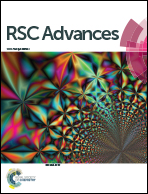TiO2–graphene nanoparticle based electrochemical sensor for the bimodal-response detection of 4-chlorophenol
Abstract
An electrochemical sensor for the sensitive and convenient determination of 4-chlorophenol (4-Cp) was developed based on TiO2-modified graphene nanoparticle casting onto screen-printed carbon electrodes (TiO2–graphene oxide (GO)/SPE). A facile hydrothermal method was performed to prepare the novel TiO2–GO nanoparticles. Scanning electron microscopy, X-ray photoelectron spectroscopy, and electrochemical impedance spectroscopy were carried out to characterize in detail the formed TiO2–GO nanoparticles. TiO2 was homogenously deposited on the graphene substrate, and the nanoparticles possessed high surface areas and fast electron transfer rates, which could greatly improve their electrocatalytic performance. Cyclic voltammetry was performed to evaluate the electrochemical properties of TiO2–GO/SPE toward 4-Cp, and the TiO2–GO film exhibited a distinctly higher activity for bimodal-response detection of 4-Cp than the GO film. At the selected experimental conditions, the oxidation peak currents were proportional to 4-Cp concentrations over the range of 0.05 μM to 20.0 μM and 20.0 μM to 200.0 μM. The lower limit of detection was 0.02 μM. The obtained results suggested that the developed sensor can be successfully used to determine 4-Cp in a concentration range within environmental levels.


 Please wait while we load your content...
Please wait while we load your content...